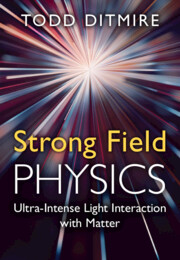Refine search
Actions for selected content:
2 results

Strong Field Physics
- Ultra-Intense Light Interaction with Matter
-
- Published online:
- 05 July 2025
- Print publication:
- 05 June 2025
4 - Strong Field Interactions with Single Atoms
-
- Book:
- Strong Field Physics
- Published online:
- 05 July 2025
- Print publication:
- 05 June 2025, pp 140-261
-
- Chapter
- Export citation
